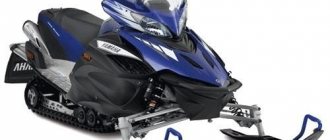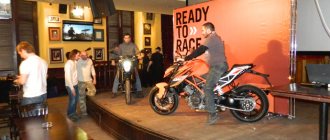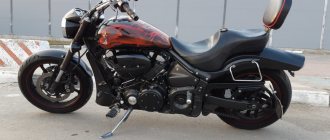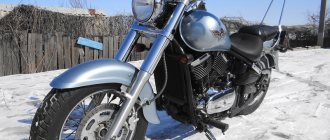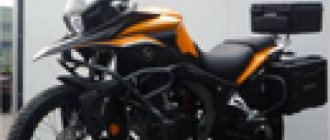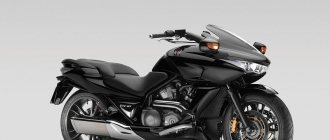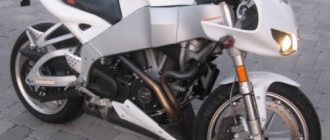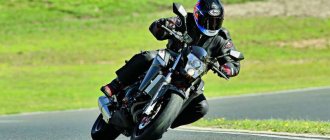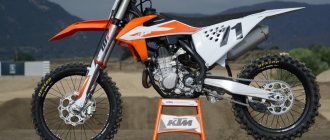Review of the Kawasaki VN 1600 Vulcan motorcycle
What I like are panniers that you can’t open or close without a key, absolute unshakability with the “sides”, excellent brakes, traction reserve in all gears, a comfortable seat, of course they could have been a couple of centimeters higher, but I’m nitpicking because -for height, but the passenger (passenger))) is just resting.
The motorcycle cruiser is 110-120, it can be more, up to 150-160, but why? ro-ta-ta, ro-ta-ta merges into a monotonous roar and the pleasure is not the same, although there are no tensions, and you can drive calmly. The suspension is a little soft, my passenger and I are on both “4” shock absorbers, but it’s still a little soft, maybe we just need to change them, but they don’t seem to be leaking... and on the waves on the highway it wobbles, but not much. Tubeless tires are just a godsend - I “caught the screw”, drove to the installation, installed the flagellum and moved on.
What is missing is ABS - after all, the motorcycle is very heavy; The seat is slightly higher (in winter you need to look in catalogues); Well, the motorcycle itself is heavy, so you can’t really go out into nature like a Honda. And perhaps that's all.
Well, yes, the consumption turns out to be 8.95 liters per hundred. If anyone is interested in anything, ask, I’ll share. And I forgot something else, when road workers cut off the top layer of asphalt, they create stripes along which, like a needle on a record, the front wheel goes, everyone probably knows - it’s an unpleasant thing, this one doesn’t react, I think, because of the width of the front wheel.
The sound is crazy!!!!! Pleasant smooth bass in all ranges. There are no lumbagoes or farts - the power commander clearly rules. Everything else is stock - although this is more than enough. Well, a quick acquaintance, inspection and verification took place. It's time to hit the road home! The engine started easily and pleased with its beautiful sound. The first few kilometers we drive around the city calmly, getting used to each other. I refuel at the first gas station - the 15 liter baud plug fits, the tank itself is 20 liters.
And here is the route. The first modest and cautious attempts to open the gas - the moto reacts kindly and friendly. The landing is very convenient and comfortable and I don’t even notice how I reached the first border. As always, past the entire queue to the barrier and on to the crossing itself. People look with interest and no one even thought to be indignant - especially looking at the airbrushing, everyone’s desire to do so clearly disappeared!)) And there is a drawing of a death girl with a scythe, a cemetery and black crows))
When the border guard asks where I’m going, I answer that I’m going to Moscow, home……..a pause in his actions for about thirty seconds and a corresponding look. I receive my stamped passport in a couple of minutes and then on. the next transition is Belarus. Everything is the same and there is no doubt + that my face has been flashing there for a long time, I don’t spend much time and that’s all - freedom!!
I jump into the saddle and accelerate. I have already gotten used to the spendthrift and become friends - a great guy!! Now you can experiment. I open up to 110-120 km/h and go. The bike runs smoothly as if glued to the road. The windshield, which can also be adjusted in height (mine was in the lowest position), perfectly protects from all sorts of flying reptiles and does not interfere with the view. The suspension perfectly absorbs all road irregularities, ruts and other delights. The motor steers excellently - if you can say so about the chaper. Very good weight distribution and layout allows you to throw it in any direction up to the platforms (steps). Due to forward flow and power command, the bike is very playful and dynamic - it breathes evenly and easily.
And here comes the first surprise of the road - heavy rain and thunderstorms. Figuring that they don’t last long, I jump onto the nearest stop and decide to wait it out. 10 min. and it’s all over - we move on. The wind deflector works at 5+ - the visor on the helmet is clean and without a single drop, the jacket and gloves are dry, but the legs………….the water creeps up the boots and pants to the thigh and then breaks out. You just need to put chaps on the front arches, otherwise you will be wet from below all the way through. On a wet road with puddles and ruts, the bike stands and behaves superbly - smoothly, accurately and confidently.
I was very pleased with the consumption at up to 120 km/h - I covered 150 miles with 13 liters. It gets dark and we find a place to sleep for the two of us. Morning. The sun is warm, the birds are singing - the thunderstorm has moved towards Moscow overnight. Let's start - at the expense of the commander it is necessary to start only with choke. I don’t want to put on a hat – it’s not comfortable wearing it on the Nomad. I knit a bandana, put on my glasses and go. After the helmet, up to 150, there is silence in the ears, there is no blowing anywhere, there is no headache, insects, sand and stones do not fly. In general - a blunder!! In modes greater than 120, fuel consumption increases and reaches 8.5 - 9 liters. By the way, the tank volume is 20 liters. Here, everyone must decide for themselves what is better for them - drive slower or pay more))
The seat is very comfortable - nothing gets numb.
The platforms are conveniently located and comfortable for the legs, but you have to put the “chaps” on the arches, otherwise your legs will slowly blow away. I would also put a “removal” on the arches - it will become more convenient and it will be possible to change the position of the legs. The standard hard cases are very comfortable and well designed. They have one drawback - they can open on the move, to prevent this from happening, it makes sense to always lock the lock. To transport things in them, it is worth buying liner bags for the cases - things will not gather dust, because the cases are not airtight. But the water didn't get there.
The suspension is very good. The fork is without adjustments, but is of a cartridge type - it works well, it hasn’t broken even once. Rear shock absorbers – 5+!!!! They have adjustable stiffness - twist knobs with marks + the ability to pump and adjust pressure. Overall, it’s a great motorcycle designed for touring and long trips. If you are thinking about a tourer, I recommend that you pay attention to this model. It will delight you for many years and kilometers with its loyalty and reliability.
The differences between the 1500/1600 are mainly in appearance, the tank is different, one and a half liters larger, the frame is slightly lower, and the overall contours of the 1600 are smoother. After 2002, both are fuel-injected, but the injection systems are different, the 1500 is a little glitchy, but the 1600 has poor engine braking. In terms of acceleration, they are approximately the same, except that the 1600 is a little better at the bottom; both spin, like all large-volume vehicles, reluctantly, but they do not feel the load/passenger at all. They say that 1600 have corrected some birth sores of 1500, there is no confirmation, because... the runs are still small. The brakes on both Tourers are excellent in their class. The seat on the 1500 is luxurious, the best in the class, on the 1600 it’s a little worse, but quite worthy. But the 1600 has an awesome standard back! The Nomad cases are simply a song: roomy, comfortable, strong, you can’t imagine anything better. At 1700 it seems worse at first glance. Well, the arches-glass-lovers in stock are very bad; when sliding, it really only goes on the arches, the rest is not damaged.
The average consumption is as follows (about the same for both): up to 120 - 6-7, then every 10 km/h + liter. It's on the highway. In the city 8-10 usually works out. It holds cruising speed up to 160 easily, acceleration is not the sharpest, but confident and smooth, without hesitations or dips.
The front suspension of both is simply gorgeous, the cartridge suspension works clearly at five points. Rear - 3 plus. For one no problem, for two and loaded - it can’t stand it, breakdowns - change for tuning. At 1600 it feels a little harder, but I’d like to add...
There are no special problems with service, everything is convenient, accessible and inexpensive. The only thing is once every 60 thousand. Replacement of timing chains is mandatory along with tensioners! This is the most painful place - if used incorrectly, tensioners fail and problems with chains begin, even very serious ones. Also, the engine is sensitive to the quality of the oil; if the window is dirty, it is better not to use it, because... The crankshaft cannot be repaired! When purchasing, be sure to have it inspected by a mechanic who works with Vulcans, including Motohelp, because problems with the motor are often expensive and time-consuming to fix; it’s easier to find one alive. For a new device this is not a problem, the real mileage is better up to 20-30 thousand.
I drove the 1500 for a year and rode a lot on the 1600. True, both were Classics, but there was more body kit than on the Nomad. And a couple of dozen different Volcanoes have been under surveillance for several years.
Dimensions and weight
In terms of height, the Kawasaki VN 1600 Vulcan can be considered high – 1130 millimeters. This is why it is not the most suitable motorcycle for short people. The saddle height is 680 millimeters. Wheelbase dimensions - 1680 millimeters.
The length of the bike is quite large - 2505 millimeters allows us to classify it as a two-wheeled giant. The width is also impressive, measuring 1040 millimeters. If a person is buying a motorcycle for the first time, then such dimensions may be intimidating at first. Indeed, it is better not to take this model as a first bike, but to choose a mid-sized cruiser, depending on the buyer’s body size.
Chassis and brakes
The frame pleases with its design: the relief pipes look great against the backdrop of the massive steering wheel and the main part of the body. The colors are chosen with taste and are suitable for people with very different color preferences. Dark brown is good for those who don’t want to stand out, and red is suitable for connoisseurs of flashy bikes.
The rear pendulum suspension has two shock absorbers. Its stroke is 95 millimeters. At the front, the suspension is a 41 mm telescopic fork with a travel of 150 mm. An excellent choice that matches the characteristics of the motorcycle.
The wheels are large, in accordance with all sizes of VN 1600. The wheels are alloy, but at the same time they look stylish. Some people think that alloy wheels look best on sports bikes, but this model shows that with the right approach, this solution is also suitable for classics.
The steering wheel of the car is powerful, befitting its massive dimensions. The Kawasaki VN 1600 Vulcan handles perfectly at different speeds. The steering wheel is comfortable to hold thanks to the specific shape of the handles. The mirrors are stylish, but nothing particularly remarkable in terms of design (typical classics).
The rear brakes are served by a single disc with a diameter of 300 millimeters, assisted by a two-piston caliper. At the front there is a practical solution in the form of two three-hundred-millimeter discs with two-piston calipers.
Engine
Compared to the 1500th Vulcan, the engine displacement is slightly larger and amounts to 1552 cubic centimeters. The V-shaped four-stroke two-cylinder engine is capable of producing peak torque of 127 Newton meters per second at 2700 rpm. Power at its peak is 67 horsepower at 4,700 rpm.
The motorcycle has a transistor ignition type. The powerful engine allows the motorcycle to accelerate in 5.29 seconds to 100 kilometers per hour! The top speed of the VN 1600 is also impressive: it is 177 kilometers per hour! Taking into account a twenty-liter gas tank and fuel consumption of 6-8 liters per 100 kilometers, the motorcycle can easily travel a couple of hundred without refueling. However, it is worth considering that, as with any other motorcycle, fuel consumption is affected by riding style.
Powerful V-twin engine
The 1700 cm3 liquid-cooled, 8-valve, single overhead camshaft (SOHC) two-cylinder V-engine with a large piston stroke was designed to produce high torque values. The diameter and stroke of the pistons here are 102 x 104 mm, respectively. Torque is approximately 15% higher than the VN1600 Classic Tourer. The valve train is based on that found on the VN2000, but uses a single overhead camshaft. This makes the rider's feedback to the engine more immediate and makes it easier to enter highways and fast-moving traffic. Electronic throttle system
A first for Kawasaki, the fully electronic throttle response system uses the on-board computer to control both the amount of fuel injected (via the fuel injectors) and the amount of air entering the engine (via the throttle valves). Perfectly matched fuel injection and throttle positions provide a smooth, natural engine response to rider input. Control over both parameters (fuel and air) makes it possible to clearly control idle speed on a cold engine. Windshield
The VN1700 Classic Tourer has increased airflow protection for the adjustable handlebar-mounted windshields. The optional windshield and deflectors on the VN1700 Classic Tourer enhance the protection from oncoming airflow. The auxiliary windshield protects the area between the headlight and the windshield when the latter is in the raised position. Deflectors mounted on the fork help deflect airflow away from the rider's legs. Dashboard
The ignition switch has the ability to remove the key from the working position. This prevents the keychain from damaging the instrument panel or fuel tank while driving. Turning the ignition switch ring to the “OFF” position stops the engine and requires reinserting the key to start it. The multi-function displays of the fuel tank-mounted instrument panel are controlled by switches located on the right handlebar. Displayed here are: a gear indicator (new for Kawasaki cruisers), a fuel gauge, a clock, an odometer, two trip meters, a range meter and an average fuel consumption meter.
6-speed transmission with overdrive
6th gear is an overdrive and allows you to drive without stress and unnecessary fuel consumption at cruising speeds on flat roads.
History of changes
The bike has undergone some changes that have benefited it. Compared to other motorcycles, there were not many changes, because the VN 1600 lasted only 5 years. Here is a brief history of the model:
- 2003 – appearance;
- 2004 – the version of Mean Streak was released;
- 2005 – appearance of the Tourer modification;
- 2008 is the last year of production of the model.
The Kawasaki VN 1600 Vulcan demonstrated what a new generation classic bike is all about. It did not create the sensation that once marked the appearance of the 750th Vulcan, but the model became a worthy continuation of the best traditions of the Kawasaki concern.
Introduction
After reading reviews and reviews of “mid-sized” cruisers these days, I found out that for complete happiness I may well need a Kawasaki, namely the VN900 model.
Having read about more or less obvious shortcomings and considering them not convincing enough to even refuse to try, I began to look for where I could touch this miracle of metric motor construction. On the Kawasaki Nederland website, when you search for a test drive, you simply get a list of dealers. Upon closer inspection, the dealer produces a list of demo motorcycles, but not a single VN900 was on the list. There you go. I just had to google it, and as a result I found a dealer not far from Utrecht, offering to ride almost everything :). Two days after the email, the answer came - there is a rental VN900 available in the Light Cruiser configuration (as I wanted!) - available at any time. And even on the day when I was just going to be in that area. Well, don't miss this opportunity!
This was the first time I drove a car for a test. But bringing your family to the airport would be difficult any other way :). Having found a free place, I parked, changed clothes and went to seek my fortune with whomever I had agreed with. I was “assigned” to a consultant boy, who harassed me a little with filling out the necessary papers, and, finally, I was given a Vulcan. Or rather, first I had to look in the parking lot among a bunch of other motorcycles and, as usual, he was standing at the very end: in full gear, with a screen and bags. They brought him out and brought him in (without any special movements), and wished me good luck for the next hour. So, I'm alone with Vulcan.
Appearance
Regardless of the modification, the Kawasaki VN 1700 Vulcan looks solid, just look at the photo once to be convinced of this. This is a huge motorcycle with a steel tubular frame, low seating position and a large tank.
Classic is the most traditional version of this bike; it is not equipped with a windshield, which fully corresponds to its name. By the way, it’s not really needed here, because the car is not suitable for high speeds.
The wheels here are alloy, which is within the class limits. Made in classic style. There are different colors, but the best models are black and chrome. The headlight is of impressive dimensions.
It’s immediately clear that, like many other cruisers, this option is suitable for riding as a two-person cruiser. However, in this regard, the Voyager, Classic Tourer and Classic LT modifications are safer, since they have rear insurance for the passenger.
Specifications
Both models are good in their own way and many users liked them. However, they have a number of significant differences in the technical base.
| Classic | Mean Streak | |
| Motorcycle type | chopper/ cruiser | Cruiser/custom |
| Motor | ||
| Engine | V2 | V2 |
| Engine capacity | 1470 cm3 | 1470 cm3 |
| Number of bars | 4 | 4 |
| Bike power | 64 horses | 72 horses |
| Cooling | Liquid | Liquid |
| Ignition | Digital | Digital |
| Piston diameter | 1.02 cm | 1.02 cm |
| Piston stroke | 0.90 cm | 0.90 cm |
| Torque | 112 N/m | 115 N/m |
| checkpoint | ||
| Type | 5 steps | 5 steps |
| type of drive | Cardan | Cardan |
| Design | ||
| Frame | Duplex (high-strength steel) | Duplex (high-strength steel) |
| Front suspension compression and rebound travel | 1.50 cm | 1.50 cm |
| Rear suspension compression and rebound travel | 1.0 cm | 0.87 cm |
| Front suspension type | (Hydraulics) (41 mm) | Telescopic fork (hydraulic) (41 mm) |
| Rear suspension type | Shock absorber (2 pcs) | Pendulum and shock absorber (2 pcs) multifunctional |
| Brakes front/rear | Disc system (300/270 mm) | Disc system (2 discs 320 mm with six-piston calipers / disc 300 mm with two-piston calipers |
| Options | ||
| Weight | 298.9 kg | 289 kg |
| Height | 1.14 m | 1.10 m |
| Seat height | 0.701 m | 0.700 m |
| Width | 0.996 m | 0.85 m |
| Length | 2,504 m | 2,410 m |
| Ground clearance | 12.4 cm | 12.5 cm |
